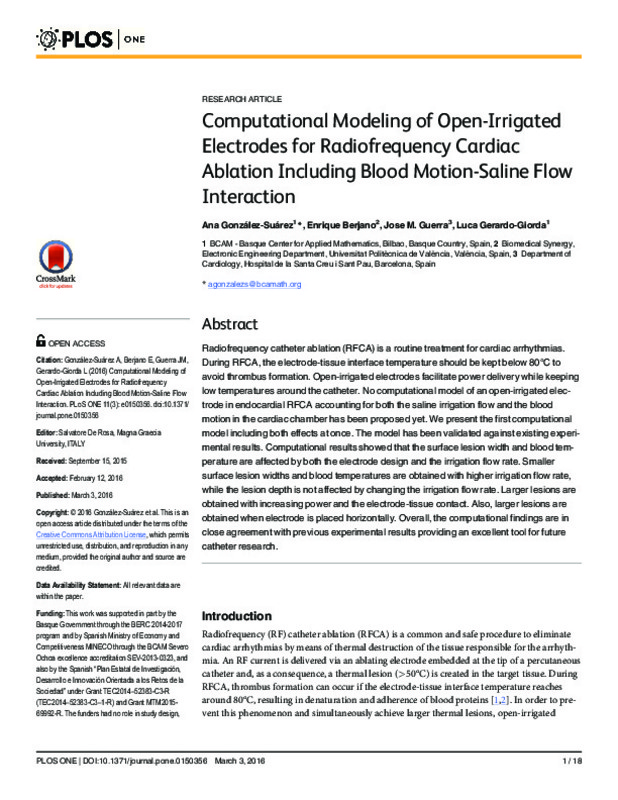DEMOLIN, J. M., EICK, O. J., MUNCH, K., KOULLICK, E., NAKAGAWA, H., & WITTKAMPF, F. H. M. (2002). Soft Thrombus Formation in Radiofrequency Catheter Ablation. Pacing and Clinical Electrophysiology, 25(8), 1219-1222. doi:10.1046/j.1460-9592.2002.01219.x
MATSUDAIRA, K., NAKAGAWA, H., WITTKAMPF, F. H. M., YAMANASHI, W. S., IMAI, S., PITHA, J. V., … JACKMAN, W. M. (2003). High Incidence of Thrombus Formation Without Impedance Rise During Radiofrequency Ablation Using Electrode Temperature Control. Pacing and Clinical Electrophysiology, 26(5), 1227-1237. doi:10.1046/j.1460-9592.2003.t01-1-00173.x
WOOD, M. A., GOLDBERG, S. M., PARVEZ, B., PATHAK, V., HOLLAND, K., ELLENBOGEN, A. L., … GOEL, A. (2009). Effect of Electrode Orientation on Lesion Sizes Produced by Irrigated Radiofrequency Ablation Catheters. Journal of Cardiovascular Electrophysiology, 20(11), 1262-1268. doi:10.1111/j.1540-8167.2009.01538.x
[+]
DEMOLIN, J. M., EICK, O. J., MUNCH, K., KOULLICK, E., NAKAGAWA, H., & WITTKAMPF, F. H. M. (2002). Soft Thrombus Formation in Radiofrequency Catheter Ablation. Pacing and Clinical Electrophysiology, 25(8), 1219-1222. doi:10.1046/j.1460-9592.2002.01219.x
MATSUDAIRA, K., NAKAGAWA, H., WITTKAMPF, F. H. M., YAMANASHI, W. S., IMAI, S., PITHA, J. V., … JACKMAN, W. M. (2003). High Incidence of Thrombus Formation Without Impedance Rise During Radiofrequency Ablation Using Electrode Temperature Control. Pacing and Clinical Electrophysiology, 26(5), 1227-1237. doi:10.1046/j.1460-9592.2003.t01-1-00173.x
WOOD, M. A., GOLDBERG, S. M., PARVEZ, B., PATHAK, V., HOLLAND, K., ELLENBOGEN, A. L., … GOEL, A. (2009). Effect of Electrode Orientation on Lesion Sizes Produced by Irrigated Radiofrequency Ablation Catheters. Journal of Cardiovascular Electrophysiology, 20(11), 1262-1268. doi:10.1111/j.1540-8167.2009.01538.x
EVERETT IV, T. H., LEE, K. W., WILSON, E. E., GUERRA, J. M., VAROSY, P. D., & OLGIN, J. E. (2008). Safety Profiles and Lesion Size of Different Radiofrequency Ablation Technologies: A Comparison of Large Tip, Open and Closed Irrigation Catheters. Journal of Cardiovascular Electrophysiology, 20(3), 325-335. doi:10.1111/j.1540-8167.2008.01305.x
Demazumder, D., Mirotznik, M. S., & Schwartzman, D. (2001). Journal of Interventional Cardiac Electrophysiology, 5(4), 377-389. doi:10.1023/a:1013224110550
Yokoyama, K., Nakagawa, H., Wittkampf, F. H. M., Pitha, J. V., Lazzara, R., & Jackman, W. M. (2006). Comparison of Electrode Cooling Between Internal and Open Irrigation in Radiofrequency Ablation Lesion Depth and Incidence of Thrombus and Steam Pop. Circulation, 113(1), 11-19. doi:10.1161/circulationaha.105.540062
Yokoyama, K., Nakagawa, H., Shah, D. C., Lambert, H., Leo, G., Aeby, N., … Jackman, W. M. (2008). Novel Contact Force Sensor Incorporated in Irrigated Radiofrequency Ablation Catheter Predicts Lesion Size and Incidence of Steam Pop and Thrombus. Circulation: Arrhythmia and Electrophysiology, 1(5), 354-362. doi:10.1161/circep.108.803650
Nakagawa H. Comparison of 12 and 56 hole electrodes for open irrigated radiofrequency ablation in a canine thigh muscle preparation: improvement in thrombus reduction with 56 small irrigation holes. <italic>Biosense Webster</italic> 2010.
WEISS, C., ANTZ, M., EICK, O., ESHAGZAIY, K., MEINERTZ, T., & WILLEMS, S. (2002). Radiofrequency Catheter Ablation Using Cooled Electrodes: Impact of Irrigation Flow Rate and Catheter Contact Pressure on Lesion Dimensions. Pacing and Clinical Electrophysiology, 25(4), 463-469. doi:10.1046/j.1460-9592.2002.00463.x
PÉREZ, J. J., D’AVILA, A., ARYANA, A., & BERJANO, E. (2015). Electrical and Thermal Effects of Esophageal Temperature Probes on Radiofrequency Catheter Ablation of Atrial Fibrillation: Results from a Computational Modeling Study. Journal of Cardiovascular Electrophysiology, 26(5), 556-564. doi:10.1111/jce.12630
Jain, M. K., & Wolf, P. D. (2000). A Three-Dimensional Finite Element Model of Radiofrequency Ablation with Blood Flow and its Experimental Validation. Annals of Biomedical Engineering, 28(9), 1075-1084. doi:10.1114/1.1310219
Gopalakrishnan, J. (2002). A Mathematical Model for Irrigated Epicardial Radiofrequency Ablation. Annals of Biomedical Engineering, 30(7), 884-893. doi:10.1114/1.1507845
Schutt, D., Berjano, E. J., & Haemmerich, D. (2009). Effect of electrode thermal conductivity in cardiac radiofrequency catheter ablation: A computational modeling study. International Journal of Hyperthermia, 25(2), 99-107. doi:10.1080/02656730802563051
JAIN, M. K., TOMASSONI, G., RILEY, R. E., & WOLF, P. D. (1998). Effect of Skin Electrode Location on Radiofrequency Ablation Lesions: An In Vivo and a Three-Dimensional Finite Element Study. Journal of Cardiovascular Electrophysiology, 9(12), 1325-1335. doi:10.1111/j.1540-8167.1998.tb00108.x
Tungjitkusolmun, S., Woo, E. J., Cao, H., Tsai, J. Z., Vorperian, V. R., & Webster, J. G. (2000). Thermal—electrical finite element modelling for radio frequency cardiac ablation: Effects of changes in myocardial properties. Medical & Biological Engineering & Computing, 38(5), 562-568. doi:10.1007/bf02345754
Abraham, J. P., & Sparrow, E. M. (2007). A thermal-ablation bioheat model including liquid-to-vapor phase change, pressure- and necrosis-dependent perfusion, and moisture-dependent properties. International Journal of Heat and Mass Transfer, 50(13-14), 2537-2544. doi:10.1016/j.ijheatmasstransfer.2006.11.045
HAINES, D. E., & WATSON, D. D. (1989). Tissue Heating During Radiofrequency Catheter Ablation: A Thermodynamic Model and Observations in Isolated Perfused and Superfused Canine Right Ventricular Free Wall. Pacing and Clinical Electrophysiology, 12(6), 962-976. doi:10.1111/j.1540-8159.1989.tb05034.x
Doss, J. D. (1982). Calculation of electric fields in conductive media. Medical Physics, 9(4), 566-573. doi:10.1118/1.595107
Berjano, E. J. (2006). Theoretical modeling for radiofrequency
ablation: state-of-the-art and challenges for the future. BioMedical Engineering OnLine, 5(1). doi:10.1186/1475-925x-5-24
Nakagawa, H., Wittkampf, F. H. M., Yamanashi, W. S., Pitha, J. V., Imai, S., Campbell, B., … Jackman, W. M. (1998). Inverse Relationship Between Electrode Size and Lesion Size During Radiofrequency Ablation With Active Electrode Cooling. Circulation, 98(5), 458-465. doi:10.1161/01.cir.98.5.458
Haemmerich, D., Chachati, L., Wright, A. S., Mahvi, D. M., Lee, F. T., & Webster, J. G. (2003). Hepatic radiofrequency ablation with internally cooled probes: effect of coolant temperature on lesion size. IEEE Transactions on Biomedical Engineering, 50(4), 493-500. doi:10.1109/tbme.2003.809488
Jain, M. K., & Wolf, P. D. (1999). Temperature-controlled and constant-power radio-frequency ablation: what affects lesion growth? IEEE Transactions on Biomedical Engineering, 46(12), 1405-1412. doi:10.1109/10.804568
NGUYEN, D. T., OLSON, M., ZHENG, L., BARHAM, W., MOSS, J. D., & SAUER, W. H. (2015). Effect of Irrigant Characteristics on Lesion Formation After Radiofrequency Energy Delivery Using Ablation Catheters with Actively Cooled Tips. Journal of Cardiovascular Electrophysiology, 26(7), 792-798. doi:10.1111/jce.12682
Hong Cao, Vorperian, V. R., Tungjitkusolmun, S., Jan-Zern Tsai, Haemmerich, D., Young Bin Choy, & Webster, J. G. (2001). Flow effect on lesion formation in RF cardiac catheter ablation. IEEE Transactions on Biomedical Engineering, 48(4), 425-433. doi:10.1109/10.915708
[-]









